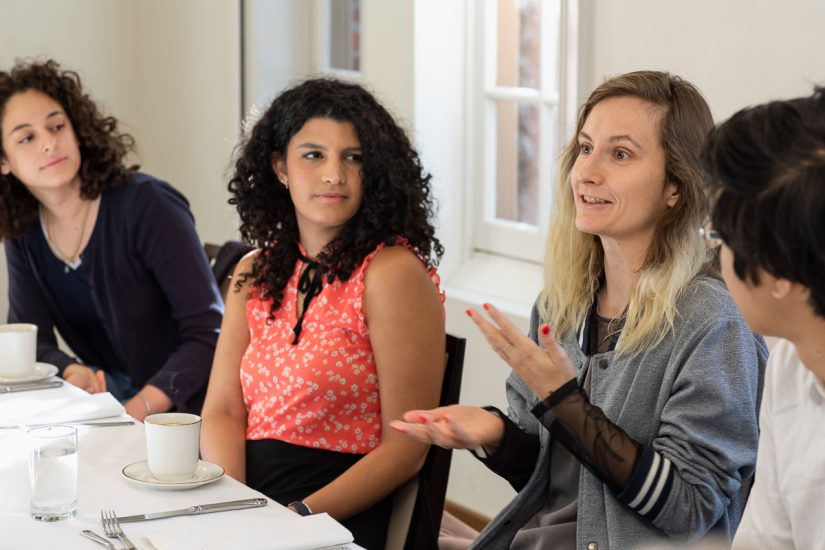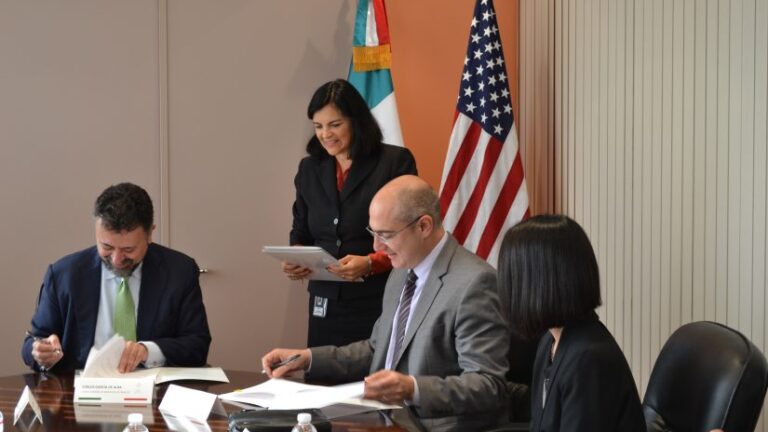
Ana Carolina Estarita Guerrero and Lea Marina Lanoue Timm listen to Johnny Nawracaj and at a recent breakfast for the USC International Artist Fellowship (IAF) Program. (USC Photo/Stella Kalinina)
At the heart of the USC International Artist Fellowship, collaboration
The USC International Artist Fellowship (IAF) provides tuition, fees, housing, travel & living expenses for international emerging artists.
It’s a casual breakfast on a Friday in November and a small, diverse group of international artists at USC have come together to talk about the pressing topics of the day — be it homelessness, gentrification, race or identity.
“These are our natural [art] practice conversations,” says Reed van Brunschot, a visual artist from Peru, by way of the Netherlands, who is mid-way through her MFA program at the Roski School of Art and Design. “It’s beautiful — people from all different cultures and places and also disciplines, and we all get each other.”
The graduate students who sit alongside van Brunschot connect and collaborate under the auspices of the USC International Artist Fellowship (IAF) Program. Since the program’s inaugural class, in 2013, it has provided tuition, fees, housing, travel and living expenses for emerging artists across disciplines from Brazil, Canada, China, Colombia, Costa Rica, Mexico, Peru, Poland, Russia, South Korea and Thailand — to date, 19 in all. The goal is ambitious, yet simple — to foster a robust international arts community, focused around the Pacific Rim, Latin America and South Asia, with Los Angeles as its creative center.
The IAF breakfasts are a vital, if informal, part of the program. It’s where van Brunschot first connected with Ana Carolina Estarita Guerrero, a digital artist from Colombia, now studying at the John C. Hench Division of Animation & Digital Arts in the School of Cinematic Arts.
“It made sense for us to merge,” says van Brunschot, who, in the process of making sculpture and installations, is no stranger to building with her hands. “When it comes to hammer and nail, [Estarita Guerrero] has no idea. When it comes to tech, I have no idea. So it’s a perfect union, us two being able to create future pieces together.”
For Estarita Guerrero, whose work is at the forefront of new media, that kind of collaboration is essential. “With the kind of media I make, it’s not only easier but necessary to be part of a network,” she explains. “It forces you to think in terms of nodes and connections with other people.” This mindset keeps her in constant conversation with her fellow IAF artists, and also with USC at large — including as a contributor to the upcoming multimedia installation Mary Shelley’s Frankenstein Re-animated, part of the USC Visions and Voices Initiative.
There is a deeply practical aspect of the fellowship, as well. Estarita Guerrero says the economic support she receives translates directly into time — the hours each week that she might otherwise be teaching now freed up to create something innovative and experimental. “Those six hours are actually one more project that I can work on,” says Estarita Guerrero. With this kind of support, she says, her work can flourish.
There are currently nine IAF fellows, across USC’s six art schools. Haoren Xu, of China, is at the USC School of Architecture, exploring the possibilities and potential of architecture and city design. Yaya Veerasilpa, an interactive media and game designer from Thailand, is pursuing her MFA at the USC School of Cinematic Arts. Wesley Chu, of Canada, is pursuing a Doctor of Musical Arts in piano performance at the Thornton School of Music. Lea Marina Lanoue Timm, of Canada, and Mariana Carreño King, of Mexico, are at the School of Dramatic Arts, pursuing MFAs in acting and playwriting, respectively. Each artist brings something new and vital to the conversation.
Sometimes the connections can be surprising. Bokyung Byun, an accomplished guitarist who is currently pursuing a doctoral degree at the Thornton School of Music, found her way into the topic of homelessness. At breakfast, she talked about performing for the homeless in Los Angeles — and as someone who lives, performs and sees a future for herself in this city and all it represents.
Indeed, the city of Los Angeles at large is an extremely powerful draw for the IAF artists. “Being here is huge for me,” says Johnny Nawracaj, a non-binary multidisciplinary performance artist who moved to Los Angeles from Montreal to study at the Roski School of Art and Design just this year. Nawracaj says the most eye-opening part has been connecting with those who know Los Angeles and its history, politics and cultural landscape best. “It’s such an expansive place.”
That sense of connection — to the city, to each other and across disciplines — is what makes the fellowship so special. “Never before have art, creativity and self-expression been more relevant to our lives as ways to make visible the everyday, celebrate diversity and connect us to others,” said USC Provost Michael Quick. And if the goal for USC is to create space for an international arts conversation that reflects that diversity, that conversation begins at the breakfast table, where the IAF scholars meet.



